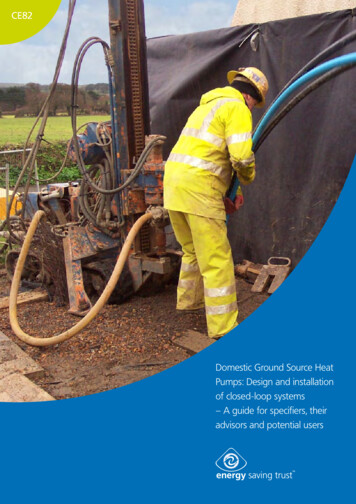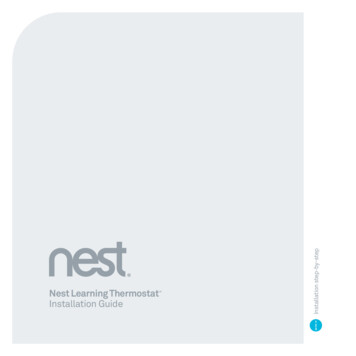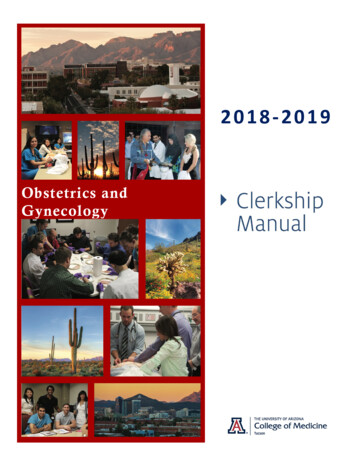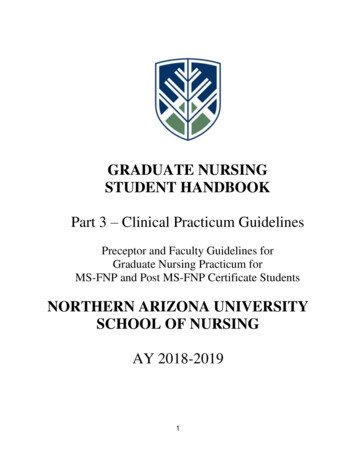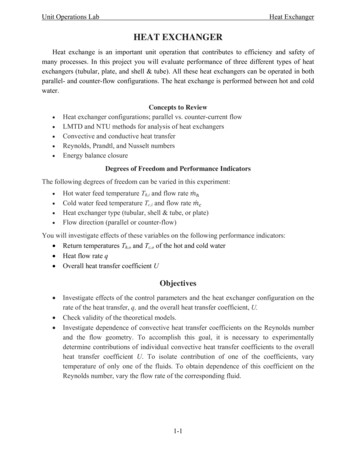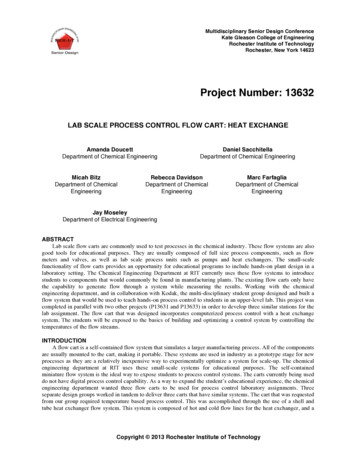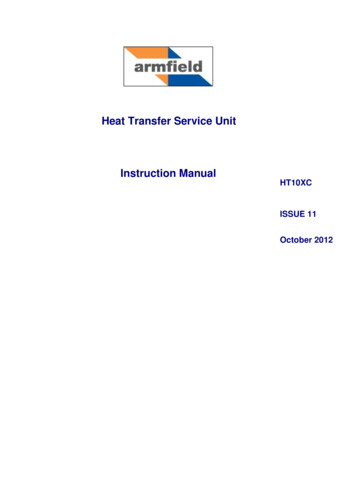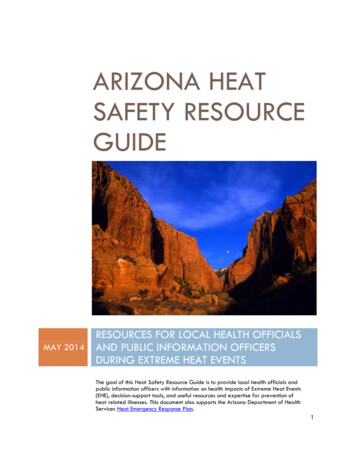
Transcription
ARIZONA HEATSAFETY RESOURCEGUIDEMAY 2014RESOURCES FOR LOCAL HEALTH OFFICIALSAND PUBLIC INFORMATION OFFICERSDURING EXTREME HEAT EVENTSThe goal of this Heat Safety Resource Guide is to provide local health officials andpublic information officers with information on health impacts of Extreme Heat Events(EHE), decision-support tools, and useful resources and expertise for prevention ofheat related illnesses. This document also supports the Arizona Department of HealthServices Heat Emergency Response Plan.1
Arizona Heat Safety ResourceGuideTABLE OF CONTENTSSummary . 3Acknowledgement . 31.0) Extreme Heat Event: Preparedness and Response . 41.1) Available Resources: Preparedness and Response . 42.0) Ensuring Access to Timely Meteorological Forecast . 42.1) Available Resources: Meteorological Forecast . 43.0) Extreme Heat Event: Notifications and Public Education. 43.1) Available Resources: Notification and Public Education . 53.2) Available Resources: Cooling Centers and Refuge/Hydration Stations . 54.0) Available Resources: Heat Safety Resource Guide . 6Glossary . 15Appendix 1: Heat Index Chart with Health Effects and Safety Recommendations . 16Appendix 2: Arizona Zone Forecast Boundaries . 17Appendix 3: National Weather Service Arizona Forecast Zones . 182
SUMMARYHeat kills by pushing the human body beyond its limits. Between 2000 and 2012, 1,535 deaths fromexposure to excessive natural heat occurred in Arizona. In 2012, there were a total of 1,572emergency department visits and a total of 212 inpatient admissions from exposure to excessivenatural heat.Most heat illnesses occur because the victim has been overexposed to heat or has overexerted his orher body for his or her age and physical condition. Anyone in Arizona can experience a heat illness oreven death from heat exposure, especially from the months of May to October. Older adults, outdoorworkers, young children, homeless people, and those who are sick are more likely to succumb toextreme heat but all residents of Arizona are at risk without appropriate precautions.Conditions that can induce heat-related illnesses often coincide with stagnant atmospheric conditionsand poor air quality. Consequently, people living in urban areas may be at greater risk from theeffects of a prolonged heat wave than those living in rural areas. Also, urban building materials, suchas asphalt and concrete, store heat longer and release heat at night more gradually than vegetatedland covers in suburban and rural areas. Heat retention produces higher nighttime temperatures incities known as the “urban heat island effect.” Prolonged hours of high temperature means greaterexposure to health risks.In 2013, a group of federal, state, and local agencies; non-profits; and university partners convenedat the Arizona Department of Health Services to discuss heat safety issues in Arizona. Thesestakeholders worked together to develop a Heat Safety Resource Guide to link each other toresources.The goal of this Heat Safety Resource Guide is to provide local health officials and public informationofficers with information on health impacts of Extreme Heat Events (EHE), decision-support tools, anduseful resources and expertise for prevention of heat related illnesses. This document also supports thecomprehensive Arizona Department of Health Services Heat Emergency Response Plan.ACKNOWLEDGEMENTThe primary agencies that partnered to prepare this Heat safety guide’s development are:Arizona Department of Economic SecurityArizona Department of Health Services – Bureauof Emergency Medical Services and TraumaSystemArizona Department of Health Services – Officeof Environmental HealthArizona Department of Health Services – Officeof Infectious DiseasesArizona Department of Health Services – PublicHealth Emergency PreparednessArizona Division of Emergency ManagementArizona Division of Occupational Safety andHealthArizona State ParksArizona State UniversityCity of Phoenix – Human Services DepartmentCity of Phoenix – Public TransitCity of TucsonMaricopa Association of GovernmentsMaricopa County Department of Public HealthMohave County Department of Public HealthNational Park Service – Southern ArizonaNational Weather Service – Flagstaff RegionNational Weather Service – Las Vegas RegionNational Weather Service – Phoenix RegionNational Weather Service – Tucson RegionPima County Health DepartmentRed Cross – Grand Canyon ChapterSalvation ArmyYuma County Public Health Services District3
1.0 Extreme Heat Event: Preparedness and ResponseEHE health risks are not equally distributed among the population. Enhanced program responses include directassessments of the health and environment of those at greatest risk during the EHE when dangerous conditionsoccur. Develop plans, resources, and distribution strategies to prepare the community. Encourage people tocheck on their neighbors and to ask their neighbors to do the same. Use 211 Arizona (www.211arizona.org)to locate community information and resources. Identify the local agencies that have a role in preventing harmfrom EHEs – identify your local emergency management for their preparedness and response plans.Defining the structure, relationships, and responsibilities for those supporting an EHE notification and responseprogram (e.g., health departments, utilities, homeless advocates) is an essential long-term coordinationactivity. This action requires establishing a means for planning and communication among the programsupporters so that available resources are used most efficiently and potentially conflicting messages fromprogram participants are clarified.EHEs are a threat to public health. Public health agencies play a part in developing and managing an EHEresponse plan. In addition, local emergency management agencies, street and sanitation departments, andhealth code enforcement staff typically have significant contact with the public. As a result, their informationdistribution networks and staff could, depending on local conditions, be a valuable resource to consider in EHEresponse planning.1.1 Available Resources: Preparedness and ResponseAgencies and organizations involved with heat safety preparedness, heat emergency response planning,training for first responders and hospitals are listed in Section 4.0 Resources.2.0 Ensuring Access to Timely Meteorological ForecastAn effective EHE notification and response program requires access to reliable meteorological forecasts toprovide lead time for implementing program elements.To enhance EHE forecasting, agencies are encouraged to use systems that electronically retrieve and evaluatereal-time National Weather Service (NWS) forecast data.2.1 Available Resources: Meteorological ForecastTo determine the level of communication and response measures each agency will implement when an EHE isforecast, local officials should use and evaluate the meteorological data from the National Weather Services.The NWS Phoenix Office, Tucson Office, Flagstaff Office, and Las Vegas Office issue warnings for extremeheat situations up to two days in advance and heat watches up to 4 days in advance. Contact information foreach NWS office is listed in Section 4.0 Resources. To locate the Office in your region, see Appendix 2. Tohelp you understand the geographic regions that NWS may issue warnings for, we have included a table toidentify areas that are affected in Appendix 3.3.0 Extreme Heat Event: Notifications and Public EducationOne of the public health challenges for EHEs is to develop and implement meaningful EHE notificationstrategies that increase public awareness and lessen future adverse health impacts.A significant source of public health impacts of EHEs is that individuals often do not recognize the dangerassociated with EHE conditions, are unable to take preventative actions or find relief, or do not have theknowledge or resources to protect themselves. There is a significant need for continued and enhanced publiceducation about the EHE risks and health impacts so that individuals are able to prepare for the onset ofdangerous weather, understand what actions and behaviors might be most effective at reducing their risk, andknow what resources are available to help them cope with extreme heat.4
Effective public notification of forecast EHE conditions helps to reduce risk. Local agencies should coordinatepublic broadcasts of information about the anticipated timing, severity, and duration of EHE conditions; andthe availability and hours of public cooling centers. Notifying the public of anticipated EHE conditions willenable many residents to prepare and will enable public assessment and intervention actions to concentrateon known high-risk individuals and locations. Likewise, advance public notification about the availability ofcooling centers and refuge/hydration stations will increase the likelihood that at-risk individuals can takeadvantage of these services.3.1 Available Resources: Notification and Public EducationAgencies and organizations providing heat safety toolkits, newsletters, brochures, promotional items in Englishand Spanish (such as quick cards, pocket guides, posters, event presentations, videos), local radio and mediasources (English and Spanish), heat stress checklists, heat safety tips for transit users in hot weather,educational and preparedness messages, and data are listed in Section 4.0 Resources.Interested researchers and decision-makers who would like to find supporting data and tools can also finddata on vulnerable populations in the Universities/Data/Vulnerabilities/Research Information section.3.2 Available Resources: Cooling Centers and Refuge/Hydration StationsAgencies and organizations that provide cooling centers, refuge/hydration stations, and water distribution tothe community are listed in Section 4.0 Resources.5
4.0 Available Resources: Heat Safety Resource GuideArizona Department of Health Services (ADHS)ProgramContactPhone numberClimate andMatthew(602) 364-3673HealthRoachMatthew.roach@azdhs.govPublic HealthEmergencyPreparednessBureau ofEmergencyMedicalServices andTrauma System(BEMSTS)Office ofInfectiousDiseasesKrista Anhelukkrista.anheluk@azdhs.govDavid Hardenhardend@azdhs.gov(602) 448-3850Sara ImholteSara.Imholte@azdhs.gov(602) 364-3889(602) 364-3188Arizona Department of Economic SecurityProgramContactPhone numberLow IncomeCommunity(602) 542-4446Home EnergyActionAssistanceProgram (CAP)Program(LIHEAP)Expertise & ResourcesLinks Heat Safety Toolkits (schools, older s, outdoor workers)dex.htm Heat-related illness AwarenessCampaign Morbidity and mortalitysurveillance and data collection Quarterly Statewide HeatPreparedness MeetingEmergency Response Plans Heat Emergency Response ponse-plans.htmNewsletters Quarterly Newsletter with timelyhttp://www.azdhs.gov/bems/documentsmessages, sometimes ion on heat related illness Literature, training and events forNews, Publications, Conferencesfirst responders and hospitalshttp://www.azdhs.gov/bems/news/Syndromic Surveillance Exploring BioSense 2.0 forhttp://www.azdhs.gov/meaningfultracking heat-related rtise & Resources Help to pay current and past dueenergy bills Help with Utility Deposits Help with energy efficiencymeasures to reduce future energycostsLinksEnergy Assistancehttps://www.azdes.gov/Landing.aspx?id 73126
Arizona Division of Occupational Safety and Health (ADOSH)ProgramContactPhone numberExpertise & ResourcesJessie Atencio (602) 542-1694 Training on heat safety in theJessie.attencioworkplace@azdosh.gov Personal protective equipment Administrative controls foremployers (shift work duties tocooler part of the day, vary workenvironment from hot to cool,change out people, leave later inthe day) Heat Campaign (Apr-Sep) Hand-outs Promotional items in English andSpanish (quick cards, pocketguides, posters, eventpresentations, videos) Resource page Heat Stress Checklists Local radio and media sources(English & Spanish)Arizona Division of Emergency Management (ADEM)ProgramContactPhone numberExpertise & ResourcesHuman Services Daniel Porth(602) 464-6500 Support and coordinate assistanceBranchDaniel.porth@to local, county, and tribalazdema.govagencies* Reception & Care Centers(shelters)* Support community-based effortsand volunteer organizationsLinksTraining Request Formhttp://www.ica.state.az.us/ADOSH/Forms/ADOSH Form TrainingRequest.pdfFile a Safety Complainthttp://www.ica.state.az.us/ADOSH/ADOSH FormsComplaintsOnly.aspxVideo: Staying Safe while Working inExtreme Heathttp://youtu.be/5w-PsE-jtZ0 (English)http://youtu.be/j88sSMOeZRU (Spanish)LinksEmergency Managementhttp://www.dem.azdema.gov/7
Arizona State ParksProgramContactPublicEllen ational Park ServiceProgramContactSouthernBob GomezArizonabob gomez@nps.govPhone number(602) 542-1996Phone number(502) 733-5102Expertise & Resources Up-to-date information on parkopenings Fire restrictions Parks newsletter Find information on individualparks Each park has a first responderand EMT, the park ranger willinform guests of heat safetyprecautions at park entrance gateor ranger-led hikesLinksExpertise & Resources Heat safety promotion throughposters and written material forvisitors Pre-activity checklist with pointersabout heat for field workersLinksPrecautions Against the teparks.com/index.html8
National Weather Service (NWS)ProgramContactPhone numberInteractivewr.mobile.alert 1-888-285NWS (iNWS)s@noaa.gov0650 /(801) 524-5131NWS - Phoenix Ken Waters(602) 275-7002ken.waters@n x223oaa.govNWS - TucsonKen DrozdKenneth.drozd@noaa.gov(520) 670-5156x223NWS Flagstaffwfgz.webmaster@noaa.gov(928) 556-9161NWS - LasVegaswvef.webmaster@noaa.gov(702) 263-9744Expertise & Resources Real-time, weather warningmessaging service to cell phonesand mobile devices Excessive heat watches andwarnings Data on temperature, data onheat watches and warnings Educational and preparednessmessages Monsoon Awareness Week Heat safety promotion Monsoon Awareness Week Excessive heat watches andwarnings Outreach events Weather safety talks Watches and warningsForecastsWeather safety resourcesWatches and warningsForecastsWeather safety resourcesLinksSign up for alertshttps://inws.wrh.noaa.gov/alertsHeat Watches/Warnings, Safety Info,Statistics, ety/heat/Keep sonhttp://www.youtube.com/NWSTucsonBeat the Heat pamphlethttp://www.wrh.noaa.gov/twc/Heat .wrh.noaa.gov/vef/9
County Health DepartmentsProgramContactPhone numberMaricopaVjollca Berisha (602) 372-2611CountyvjollcaberishaDepartment of @mail.maricopPublic Health – a.govOffice ofEpidemiology& DataServicesMaricopaJeanene(602) 506-4926CountyFowlerDepartment of jeanenefowlerPublic Health@mail.maricopa.govMohaveCountyDepartment ofPublic HealthPima CountyHealthDepartmentExpertise & Resources Heat morbidity and mortalitysurveillance Hospital discharge data Exploring BioSense 2.0 fortracking heat-related conditions LinksWeekly and annual heat-associateddeath es/EPI/Reports/heat.aspxResources on heat-related illness, heattips, statistics, water and shelter, waterdonation and collection mapwww.heataz.org Provide water to the homelesspopulation through Healthcare forthe HomelessHeat brochuresData on heat-caused and heatrelated deathsHeat safety tips, FAQ'sBeat the Heat tips, FAQs, stages of heatillness, weather service d 169&pageId 20216Health effects and heat ealth Bruce Leemingbruce.leeming@mohavecounty.usAaron Pachecoaaron.pacheco@pima.gov(928) 718-4949(520) 243-7745 Heat Safety Tips & FAQsYuma CountyMichael LeBrunPublic HealthMike.lebrun@Services District yumacountyaz.gov(928) 317-4624 Emergency management supportCooling stations when poweroutage*www.healthelinks.com/10
Maricopa Association of Governments (MAG)ProgramContactPhone numberHuman Services Brande Mead(602) 452-5060bmead@azmag.govExpertise & Resources Heat Relief Network maps(locations for cooling centers andrefuge stations during excessiveheat)LinksHeat Relief Network FAQshttp://www.azmag.gov/Documents/CoC2013-05-22 Tips-to-Avoid-HeatRelated-Illnesses.pdfWater Collection/Donation Siteshttp://www.azmag.gov/Documents/HS2013-05-22 2013-Collection-andDonations-Sites v1.pdfWater Hydration Stations and 13-05-22 2013-Hydration-Stationsand-Refuge-Locations v1.pdfTips to Avoid Heat-Related -06 Tips-to-Avoid-HeatRelated-Illnesses.pdf11
City of Phoenix (COP)ProgramContactHuman Services Kristina BleaDepartmentkristina.blea@phoenix.govPublic TransitPhone number(602) 495-7519Matt Heil(602) 261-8254Matthew.heil@phoenix.govExpertise & ResourcesLinksHeat Relief Network Coordinates Mayor’s “Call forhttp://phoenix.gov/humanservices/progrWater” and Phoenix Heat Reliefams/volunteer/heatrelief/index.htmlNetwork Summer Respite Program forSummer ogr Administer, monitor, coordinateams/volunteer/sumrespite/index.htmlwater and critical item distributionto the community Training and technical assistance instarting a Heat Relief Network(HRN) in your community Heat Fact Sheet Personal Cool/Mantengase aign Tips for transit users in hot weather ool/index.html Heat safety flyers (English andSpanish)12
Universities/Data/Vulnerabilities/Research InformationProgramContactPhone numberExpertise & ResourcesArizona StateSharon Harlan (480) 727-6780 Statistical analysis of health dataUniversitysharon.harlanto identify vulnerable populations(ASU)@asu.eduand places and compare impactsacross different health outcomesUrban Support development of healthVulnerability tooutcome-based warning andClimateimplementation programsChange Scientific articles on neighborhood(UVCC) Projectmicroclimates and human health Science magazine for schools andNancy SeloverOffice of thegeneral ona StateGlobal Institute Climatologist)ofSustainabilityLinksNeighborhood Effects on Heat Deaths:Social and Environmental Predictors ofVulnerability in Maricopa County, C3569676/Heat-Related Deaths in Hot Cities:Estimates of Human Tolerance to HighTemperature cupation and Environmental HeatAssociated Deaths in Maricopa County,Arizona: A Case-Control 0.1371%2Fjournal.pone.0062596Interactive Map of Maricopa CountyCooling Centershttp://www.coolme.todayChain Reaction -and-environment-our-heathabitat/ASU Global Institute of Sustainabilityhttp://sustainability.asu.edu13
Salvation ArmyProgramContactProject HopeBrent BabbBrent.Babb@usw.salvationarmy.orgPhone number(602) 302-8861Expertise & Resources Informational brochures withresources for homeless Mobile hydration stations*LinksProject -services/c168qEmergency Disaster gency-disaster-services/c19arRed CrossProgramGrand CanyonChapterContactPhone numberScott Keyes(602) 336-6672Scott.keyes@redcross.org*Available in times of emergencyExpertise & Resources Training and PreparednessEducation Shelters during disaster*LinksHeat Wave t-wave14
GLOSSARYHeat IndexA measure used by the National Weather Service to communicate the combined effects oftemperature and humidity on human thermal comfort. The Heat Index is reported in degreesFahrenheit in the United States and is appropriate for shaded conditions. Exposure to fullsunshine can increase the heat index by 15 degrees.Heat CrampsPainful muscle cramps and spasms, usually in muscles of legs and abdomen. Heavy sweating.Although heat cramps are the least severe, they are often the first signal that the body ishaving trouble with the heat.Heat Exhaustion Typically occurs when people exercise heavily or work in a hot, humid place where bodyfluids are lost through heavy sweating. Blood flow to the skin increases, causing blood flowto decrease to the vital organs. This results in a form of mild shock. If not treated, thevictim’s condition will worsen. Body temperatures will keep rising and the victim may sufferheat stroke.Heat StrokeA life-threatening condition. The victim’s temperature control system, which producessweating to cool the body, stops working. The body temperature can rise so high that braindamage and death may results if the body is not cooled quickly.Sun StrokeAnother term for heat stroke.Extreme HeatEventConditions defined by summertime weather that is substantially hotter and/ormore humid than average for a location at that time of year. Conditions can increase theincidence of mortality and morbidity in affected populations.Excessive Heat Conditions are favorable for an excessive heat event to meet or exceed local ExcessiveWatchHeat Warning criteria in the next 24 to 72 hours defined by NWS.Excessive Heat Heat Index values are forecast to meet locally defined advisory criteria for 1 to 2 daysWarning(daytime highs 105-110 F) defined by NWS.Heat AdvisoryHeat index are forecast to meet locally defined advisory criteria for 1 to 2 days(daytime highs 100-105 Fahrenheit).15
APPENDIX 1: Heat Index Chart with Health Effects and Safety RecommendationsExtreme DangerDangerExtreme Caution FCautionMost common in AZRELATIVE HUMIDITY 03110105Heat Index: 130 degrees FHeat Index: 105-129degrees FHeat Index: 90-104degrees FHeat Index: 80-89degrees 9917879798070717171717172Health Effect: Heatstroke/sunstroke is highly likely with continued exposure.Recommendations: Avoid strenuous outdoor activity. Stay indoors in an air- conditionedfacility. Stay well-hydrated. Drink 10 gulps every 20 minutes. Check on your family, friends,and neighbors.Health Effect: Sunstroke, heat cramps and heat exhaustion are likely. Heat stroke is possiblewith prolonged exposure and/or physical activity.Recommendations: Avoid strenuous outdoor activity. Stay indoors in an air- conditioned facility.Stay well-hydrated. Drink 10 gulps every 20 minutes.Health Effect: Sunstroke, heat cramps, and heat exhaustion are possible with prolongedexposure and/or physical activity.Recommendations: Limit strenuous outdoor activity. Limit your time outdoors. Stay well-hydrated.Drink 10 gulps every 20 minutes.Health Effect: Fatigue is possible with prolonged exposure and/or physical activity.Recommendations: Limit your time outdoors. Stay well-hydrated. Drink 10 gulps every 20minutes.16
APPENDIX 2: Arizona Zone Forecast ?wfo psr&image azzones.jpg17
APPENDIX 3: National Weather Service Arizona Warning Forecast ZonesAZ Zone NumberWarning Zone NameCounty Warning Area1Northwest PlateauLas Vegas CWA2Lake Havasu and Fort MojaveLas Vegas CWA3Northwest DesertsLas Vegas CWA4Kaibab PlateauFlagstaff CWA5Marble and Glen Canyons, including PageFlagstaff CWA6Grand Canyon CountryFlagstaff CWA7Coconino PlateauFlagstaff CWA8Yavapai County MountainsFlagstaff CWA9Northeast Plateaus and Mesas (N of Highway 264)Flagstaff CWA10Chinle ValleyFlagstaff CWA11Chuska Mountains and Defiance PlateauFlagstaff CWA12Little Colorado River Valley, Coconino CountyFlagstaff CWA13Little Colorado River Valley, Navajo CountyFlagstaff CWA14Little Colorado River Valley. Apache CountyFlagstaff CWA15West Mogollon Rim, including FlagstaffFlagstaff CWA16East Mogollon RimFlagstaff CWA17White MountainsFlagstaff CWA18Northern Gila CountyFlagstaff CWA19Northern Greenlee CountyTucson CWA20Lower Colorado River Valley AZPhoenix CWA21West Central DesertsPhoenix CWA22Northwest Maricopa CountyPhoenix CWA23Greater Phoenix AreaPhoenix CWA24Southern Gila/Tonto National Forest FoothillsPhoenix CWA25Yuma/Martinez Lake and vicinityPhoenix CWA26Southwest DesertsPhoenix CWA27Southwest Maricopa CountyPhoenix CWA28Northwest and North-Central Pinal CountyPhoenix CWA29Southeast Pinal CountyTucson CWA30Upper Gila River CountyTucson CWA31Western Pima CountyTucson CWA32Tohono Odoham NationTucson CWA33Tucson Metro/Marana/Green ValleyTucson CWA34Santa Cruz CountyTucson CWA35Cochise CountyTucson CWA36Lake Mead National Recreational AreaLas Vegas CWA37Yavapai County Valleys and BasinsFlagstaff CWA38Oak Creek and Sycamore Canyons, including SedonaFlagstaff CWA39Black Mesa AreaFlagstaff CWA40Northeast Plateaus and Mesas (S of Highway 264)Flagstaff CWAAdapted from National Weather Service Forecast Office (2012). Retrieved fromhttp://www.wrh.noaa.gov/psr/redirect.php?wfo psr&image azzones.jpgArizona County ninoYavapaiCoconino; NavajoApache; NavajoApacheCoconinoNavajoApacheCoconinoCoconino; NavajoApache; NavajoGilaGreenleeLa PazLa PazMaricopaMaricopaMaricopa; Pinal; GilaYumaYumaMaricopaPinalPinalGraham; GreenleePimaPimaPimaSanta CruzCochiseMohaveYavapaiCoconinoNavajo; ApacheNavajo; Apache18
For comments, questions, and feedbackPlease contact:Arizona Department of Health ServicesOffice of Environmental HealthClimate & Health Program150 N. 18th Avenue, Suite 140Phoenix, AZ 85007(602) 364-3128extremeweather@azdhs.gov19
forecast, local officials should use and evaluate the meteorological data from the National Weather Services. The NWS Phoenix Office, Tucson Office, Flagstaff Office, and Las Vegas Office issue warnings for extreme heat situations up to two days in advance and heat


